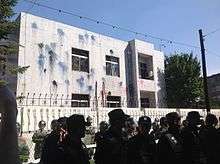2012 China anti-Japanese demonstrations
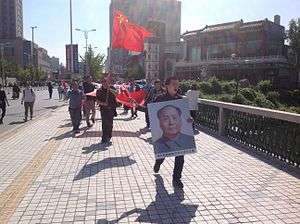
The China anti-Japanese demonstrations of 2012 were a series of initially peaceful demonstrations held across major cities in China during August and September 2012. The main cause of the demonstrations was the escalation of Diaoyu Islands dispute (Diaoyu islands known as Senkaku in Japan) between China and Japan around the time of the anniversary of "September 18 Incident". The protesters in several cities later became violent and the local authorities began arresting demonstrators and banning the demonstrations.
Background
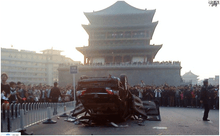
The Senkaku Islands (in Japanese; Diaoyu Islands in Chinese) are offshore islands near Taiwan, and have been a subject of territorial dispute between the governments of the People's Republic of China, the Republic of China and Japan.[1] Prior to the demonstrations, there were many cases of protests over the sovereignty of the islands, most notably those in China in 2005. September 18 marks the anniversary of the 1931 Japanese invasion of Manchuria, the memories of which fuel anti-Japanese sentiment in China.[2]
After the 2010 Senkaku boat collision incident, China stopped exporting rare earth to Japan.[3]
Incidents leading up to the protests

On 16 April 2012, Tokyo's prefectural governor Shintaro Ishihara publicly announced his decision to let Tokyo Municipality purchase the island from its private owner.[5]
On 4 July 2012, three Japanese coast guard boats made an official inspection of one Taiwanese ship near the disputed island.[4] After the inspection, Japanese coast guard and Taiwanese coast guard stood face to face.[4]
On 7 July 2012, Japanese prime minister Yoshihiko Noda expresses his consideration for the Japanese government to buy the disputed islands. The Chinese government angrily protested; Ministry spokesman Liu Weimin retorted "No one will ever be permitted to buy and sell China's sacred territory".[6][7]
On 15 August 2012, activists from Hong Kong sailed to, and landed on one of the disputed islands, but were stopped by the Japan Coast Guard. Seven activists jumped from the ships to swim ashore, five of whom reached the island; the other two turned back to the ships. The activists and their ship were detained by Japanese authorities.[8] The detained activists were deported two days later.[9]
First wave of protests
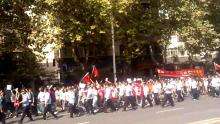
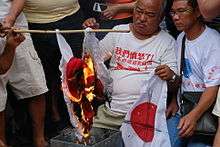
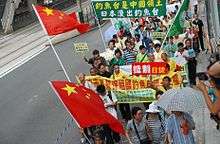

After the detainment of Hong Kong activists by the Japanese Coast Guard, Netizens in Mainland China called for a nationwide protest against Japan on 19 August.[11][12][13]
In Beijing, citizens began protesting in front of the Japanese embassy on 15 August. On the morning of 19 August, a crowd gathered and held placards bearing phrases such as "Return us the Diaoyu Islands" and "Japan must confess her crimes" in protest.[13]
In Shenzhen, protesters marched down the streets chanting slogans such as "Defend the Diaoyu Islands" and "Smash Japanese Imperialism", called for the boycott of Japanese goods and for the government to retake the islands.[14][15] In the process, many protesters tore up Japanese flags and smashed Japanese-branded cars[16] and vandalized shops selling Japanese goods;[17] rocks were hurled at a Ramen shop.[18] The protests lasted till about 2pm.[19] According to Sing Tao Daily, the government sent in large numbers of armed police, who called for an end to the violent protests, began driving the protesters away and detaining several over-reacting protesters.[20] On 14 September, the Shenzhen Police detained 4 protesters for violating private property rights by deliberately smashing roadside cars.[21]
The anti-Japanese protests were occasionally exploited by protesters who sought to criticize the Chinese government. Such demonstrations included marching with posters of the late Chinese leader Mao Zedong—perceived to be more assertive on issues of sovereignty than current leaders, as well as signs about corruption, food safety, and income inequality.[22] Supporters of the ousted anti-capitalist leader Bo Xilai also had a showing during the protests.[23]
There were also protests of varied intensities in other major cities such as Jinan, Qingdao, Guangzhou, Taiyuan, Shenyang, Changchun, Harbin, Chengdu and Hangzhou. There were police officers maintaining order at the scenes to prevent incidents of violence.[13]
Reactions
China
- On 19 August, the Ministry of Foreign Affairs has strongly protested to the Japanese Ambassador to China. Spokesperson Qin Gang expressed, with regards to the landing of Japanese activists on the disputed islands, that such illegal action is a breach of Chinese territorial sovereignty and that Japan should handle current actions appropriately to avoid stirring up bilateral relations.[24]
- On 20 August, the Fujian provincial government decided to delay commemoration activities held with the Japanese Okinawa prefecture, citing current unsuitable atmosphere for such celebrations in the country. The activities were originally scheduled for 4 September.[25]
Japan
- On 19 August, Vice Foreign Minister Kenichiro Sasae expressed that the protests made by China are "unacceptable" and voiced regret over anti-Japanese protests in China.[26][27]
- On 20 August, the 10 Japanese activists who landed on the disputed islands were prosecuted for law-breaking and put under trial by the Okinawan police.[28][29]。
- On 20 August, Chief Cabinet Secretary Osamu Fujimura told a news conference that "Both countries do not want the Senkaku issue to affect overall bilateral ties. The Sino-Japanese relationship is one of the most important bilateral ties for Japan, and it is indispensable for the stability and prosperity of the Asia-Pacific region for China to play a constructive role".[30]
- On 20 August, the ruling Democratic Party of Japan proposed to the government to take appropriate actions to prevent incidents of detaining activists from recurring.[31]
Media comments
- China Youth Daily commented that the protests occurred as a result of wrongful attitude and actions on Japan's part, which had "hurt the feelings of the Chinese people". It claimed that the boycott of Japanese products is a sharp stand to "express the inviolable dignity of the Chinese people", and denounced instances of beating and smashing.[32]
- BBC correspondent in Beijing Martin Patience claims that the protests were "almost certainly sanctioned by the Chinese authorities" and that the government frequently used anti-Japanese sentiment to "deflect criticism of their rule" in the past.[33]
- CNN expresses that "both nations would benefit from resolving the dispute quickly, with China facing a leadership change later in the year and Japan facing separate territorial fights with Seoul and Moscow".[34]
- Reuters remarked that the anti-Japanese protests "reflect bitter Chinese memories of Japan's occupation of large parts of China in the 1930s and 1940s."[30]
Second wave of protests
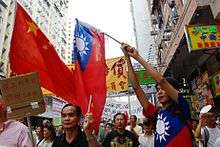
- On 11 September, China sent two patrol ships to the islands to demonstrate its claim of ownership.[36] Japan formally nationalizes the three islands that were held in the ownership of Kunioki Kurihara.[37][38]
- On 13 September, Chinese government submit nautical chart with baselines of the territorial sea on disputed islands to United Nations.[39][40] Former president of Republic of China Lee Teng-hui remarked "The Senkaku islands were Japanese territory in the past and are still so at present."[41]
- On 15 September, a large number of citizens in mainland China participated protest marches and called for boycott of Japanese products.[42] But in some cities, demonstrations had become out of control, fire vandalism and other criminal acts occurred in Changsha and Qingdao. Across numerous cities, Japanese made cars have been targets of vandalism.[43] Around 10 Japanese companies in Qingdao were damaged.[44] Anti-Japanese protesters set on fire a sales outlet of Toyota Motor.[44] Panasonic factory in Shandong was set ablaze and Panasonic factory in Suzhou was also damaged by protesters.[44][45] Heiwado, Japanese department store in Changsha was ransacked.[45] JUSCO, a Japanese department store in Qingdao was also ransacked.[45] Several thousand protesters also broke into the Garden Hotel in Guangzhou housing the Japanese Consulate General, smashed windows and attacked Japanese restaurant.[45][46]
- In the weekend of 15–16 September, Citizens in mainland China participated in protest marches and called for a boycott of Japanese products in as many as 85 Chinese cities,[47] including Shanghai, Shenyang, Zhengzhou, Hangzhou and Harbin, as well as Hong Kong[48][49] Demonstrations escalated to arson of Japanese vehicles and other criminal acts in Beijing,[50] Shenzhen,[50] Guangzhou,[51] Changsha,[52][53] Suzhou,[50] Mianyang, Xi'an[53][54][55] and Qingdao[50]
- There were protests in Los Angeles,[56] Houston, San Francisco,[57] New York[58] and Chicago, as well as a petition to the US government and Congress to take a neutral stance over the dispute.[59]
- South China Morning Post reporter Felix Wong was reportedly beaten by police in Shenzhen while covering the protests.[60]
- US Defense Secretary Leon Panetta told reporters "I am concerned that when these countries engage in provocations of one kind or another over these various islands that it raises the possibility that a misjudgment on one side or the other could result in violence and could result in conflict"[61]
- On 16 September, China officially announced to submit the plan to request natural extension of their continental shelf up to Okinawa Trough extend the EEZ to UN Commission on the Limits of the Continental Shelf.[62] In Shenzhen, about 2,000 protesters tried to push their way into a Chinese Communist Party facility, and clashed with People's Armed Police.[46] Protesters hurled bottles at the police guard in front of the Communist Party facility and threw rocks at the vehicles parked in the lot of the Communist Party building.[63]
- On 17 September, Kōichirō Genba said that there was a mutual understanding that the United States would defend the islands, even though the subject was not discussed with the Americans.[64]
- On 18 September, people in over 180 cities of China attend protests on the 81st anniversary of the Mukden Incident.[65]
- The car of Gary Locke, U.S. Ambassador to China was blocked from entering the Japanese embassy, by protesters who chanted slogans referencing the U.S.–Japan Security Treaty.[66] Protesters hurled bottles at the U.S. ambassador’s car and grabbed the American flag.[67] Then, Chinese security forces broke up the band of protesters such that, according to Locke, "It was all over in a matter of minutes, and I never felt in any danger." Chinese officials have expressed regret over the case and are investigating the "individual" incident.[68]
- Anti-Japanese protesters hurl ink bottles at the wall of the Japanese Consulate General in Shenyang.[35]
- On 25 September, Japanese and Taiwanese ships sprayed water at each other after a Taiwanese flotilla briefly sailed into what Japan says are its territorial waters.[69]
Reactions
- From 17 to 18 September, the Japanese School of Beijing canceled classes.[46]
- Honda temporarily closed down all of its five major assembly plants in China. Toyota left temporary closure decisions to subsidiaries to decide on their own based on local conditions. Nissan temporarily closed two of its three factories in the country. Mazda decided to suspend production at its Nanjing plant for four days. Sony decided to suspend two of its seven factories in China for a short time. Two Panasonic factories in China, located in Qingdao and Suzhou, were damaged by attacks. Canon temporarily closed down three of its factories in China. Kobe Steel suspended operations at four factories by September 19, 2012. Fast Retailing suspended operations at 19 of its outlets in China.[70]
- On 18 September, the Japanese right-wing group Ganbare Nippon, which had previously organized landings onto the disputed islands, organized an anti-Chinese counter-protest in Tokyo which commanded a turnout of about 50.[71]
Crackdown

On 17 September, police in the city of Xi'an banned large protests and forbade the use of phone and online messages to organize illegal protests. For the duration of the week, paramilitary troops in Shanghai provided round-the-clock protection to the Japanese consulate, stripping demonstrators of projectiles, warning them against violence with megaphones, and limiting demonstrators' time at the site to a few minutes.[72] On September 18, police in Qingdao city arrested six people for violent acts in connection with the demonstrations. Guangzhou authorities arrested 18 people who committed anti-Japanese vandalism and asked the public to submit evidence against other violators.[73] Governments elsewhere in Guangdong Province warned citizens against being present in large crowds.[74]
On 19 September, national authorities deployed riot police to suppress existing protests and to prevent their re-occurrence. Stations near to protest sites were closed by Beijing subway authorities,[75] roads were re-opened to traffic, and Beijing-wide text messages warned citizens against further demonstrations. Outside of minor protests in Shanghai, no demonstrations were reported on the 19th. Police stations across the country vowed retribution against rioters on Weibo, and China's commerce ministry urged foreign companies to report damage to the authorities.[76] The Japanese embassy in Beijing confirmed that there were no longer protests at that location, and Japanese businesses which had shut down during the protests re-opened.[2][75]
On 21 September, dozens of Japanese coast guard officials and Okinawa Prefecture police officers landed on the Uotsuri island, a largest island of Senkaku islands to prepare for the landing of Taiwanese activists.[77]
On 22 September, the United States Marine Corps and Japanese Ground Self-Defense Force proceeded with an amphibious assault drill on the scenario of retaking an island occupied by enemy forces.[78]
Economic impact
During the protests against Japan, there have been calls of boycotts of Japanese goods in addition to the destruction of several existing Japanese products.[79][80] Many Japanese businesses and factories in China were shuttered in reaction to the protests.[81] Some Chinese group tours to Japan were cancelled,[82][83] dealing a blow to the Japanese tourism industry.[84] The Japanese car manufacturing industry has suffered a loss of $250 million between 15–21 September due to the production of about 14,000 cars being suspended.[85] The Guardian predicted a global slowdown of economy due to the protests.[86]
Chinese authorities asked booksellers in Beijing to ban books by Japanese authors and titles about Japanese topics, and pressured Chinese publishers not to translate and publish Japanese content in response to China-Japan conflict.[87] Then Bookstores got rid of all publications related to Japan or written by Japanese authors.[88][89] On October 12, the entrepreneur-philanthropist Chen Guangbiao spent over $770,000 of his own money to buy new Geely cars for 172 owners of Japanese cars that were vandalized during the protests.[90]
Reactions
The Ministry of Foreign Affairs urged people to express thoughts "rationally and within the law".[42]
Japan Prime Minister Yoshihiko Noda urged China to prevent anti-Japan violence.[91]
President Ma Ying-jeou remarked the waters surrounding the Diaoyutais are traditional fishing grounds of Taiwanese fishermen.[92]
United States urged calm in the China–Japan islands dispute.[93]
See also
- 2005 anti-Japanese demonstrations
- Action Committee for Defending the Diaoyu Islands
- Anti-Japanese sentiment
- Anti-Japanese sentiment in China
- China Federation for Defending the Diaoyu Islands
- China–Japan relations
- Japan–Taiwan relations
References
- ↑ "Chinese Protest at Japanese Embassy". Voice of America. 15 September 2012. Retrieved 16 September 2012.
- 1 2 Wei, Sui-Lee (Sep 19, 2012). "China clamps down on anti-Japan protests". Reuters.
- ↑ "China rare earth exports to Japan still halted". Associated Press. Bloomberg. October 21, 2010. Retrieved 21 September 2012.
- 1 2 3 "護保釣船 海巡與日艦擦撞". China Daily News (Taiwan). 4 July 2012. Retrieved 30 September 2012.
- ↑ "Tokyo to buy disputed islands: governor". Channel NewsAsia. 17 April 2012. Retrieved 17 September 2012.
- ↑ "China dismisses Japan plan to buy disputed islands". Reuters. 8 July 2012. Retrieved 17 September 2012.
- ↑ "Japan protests at Chinese ships near disputed islands". BBC News. 11 July 2012. Retrieved 17 September 2012.
- ↑ Sheila A. Smith (16 August 2012). "Why Japan, South Korea, and China Are So Riled Up Over a Few Tiny Islands". The Atlantic. Archived from the original on 18 August 2012. Retrieved 18 August 2012.
- ↑ Yuan, Elizabeth (17 August 2012). "Japan deporting Chinese held over island landing". CNN. Archived from the original on 18 August 2012. Retrieved 18 August 2012.
- ↑ See the photography""9.18"推升反日情绪,仇恨教育应否提倡?". Voice of America. September 18, 2012. Retrieved 2012-09-28.
- ↑ "中国网民"发起多个城市反日游行"". BBC中文网. 2012-08-16. Retrieved 2012-08-19.
- ↑ "大陆网民继续号召举行反日大示威". BBC中文网. 2012-08-18. Retrieved 2012-08-19.
- 1 2 3 "中国10多个城市的群众游行抗议日本右翼分子非法登上钓鱼岛". 新华网. Retrieved 2012-08-19.
- ↑ "中国多地口号"打倒日本帝国主义" 举行反日大游行". 厦门热线. 2012-08-19. Retrieved 2012-08-19.
- ↑ "深圳广州数千人参加反日保钓游行示威". 凤凰网. Retrieved 2012-08-19.
- ↑ 中國反日遊行失控 見日本車就砸就推翻. 苹果日报 (in Chinese).
- ↑ 深圳有反日示威者破壞一輛日產警車 (in Chinese). 香港文匯報.
- ↑ "Territorial tensions flare between China and Japan". 洛杉矶时报. 2012-08-19. Retrieved 2012-08-19.
- ↑ 张慧 李庭深 (2012-08-19). "内地爆发反日游行 有日产警车被踩踏、打砸并推翻". 凤凰卫视. Retrieved 2012-08-19.
- ↑ 李建人 (2012-08-20). "20城大游行 反日怒火席捲 警拘多人". 星岛日报. Retrieved 2012-08-20.
- ↑ 深圳4人八月打砸日系车被批捕. 网易新闻 (in Chinese). Retrieved 2012-09-15.
- ↑ "In protests, Mao holds subtle messages for Beijing". Associated Press. September 20, 2012. Archived from the original on September 22, 2012.
- ↑ "INSIGHT: Mao references in anti-Japan protests a concern for Chinese authorities". Asahi Shimbun. September 18, 2012.
- ↑ "中方对日本右翼分子登上钓鱼岛表示强烈抗议". 中国新闻网. 2012-08-19. Retrieved 2012-08-20.
- ↑ 乌云春 (2012-08-22). "中日地方交流活动或因钓鱼岛事件影响被取消". 环球时报. Retrieved 2012-08-22.
- ↑ 陈薇 (2012-08-20). "日本拒绝中方抗议称中国保钓者登岛在先". 环球时报. Retrieved 2012-08-20.
- ↑ "中国抗议日人登钓岛 日本不接受". BBC中文网. 2012-08-20. Retrieved 2012-08-20.
- ↑ 覃博雅 (2012-08-20). "日媒:日本警方开始审讯10名登钓日本人". 人民网. Retrieved 2012-08-20.
- ↑ "视频:日方拟以违反轻犯罪法起诉登钓鱼岛右翼分子". 深圳卫视. 2012-08-20. Retrieved 2012-08-20.
- 1 2 "Japan says disputed islands should not hurt key China ties". Reuters. 2012-08-19. Retrieved 2012-09-17.
- ↑ "日本民主党定决议案 要求防止中国人再登钓鱼岛". 中国新闻网. 2012-08-20. Retrieved 2012-08-20.
- ↑ 曹林 (2012-08-20). "中国青年报:砸同胞日系车蠢行不是爱国是害国". 中国青年报. Retrieved 2012-08-20.
- ↑ "Anti-Japan protests across China over islands dispute". BBC. 2012-08-19. Retrieved 2012-08-19.
- ↑ "Report: Japanese group lands on disputed island". CNN. 2012-08-19. Retrieved 2012-08-19.
- 1 2 Akira Kudo; Koichi Yonemura; Mayumi Otani; Koichi Kirino (2012-09-19). "China tries to control national sentiment by suppressing some demonstrations". Mainichi. Retrieved 2012-09-20.
- ↑ Jonathan Marcus (2012-09-11). "BBC News - China sends patrol ships to disputed East China Sea islands". Bbc.co.uk. Retrieved 2012-09-16.
- ↑ "Monday, September 10, 2012 (PM), Press Conference by the Chief Cabinet Secretary (Excerpt)". Tokyo: Kantei (Cabinet Secretariat), Cabinet Public Relations Office, Japan. 2012-09-10. Retrieved 2012-09-16.
CHIEF CABINET SECRETARY FUJIMURA: 1.There is no doubt that the Senkaku Islands are clearly an inherent territory of Japan, in light of historical facts and based upon international law......
- ↑ "Japan buys three of Senkaku Islands from owner; Mainichi Shimbun". www.mainichi.jp. Retrieved 2012-09-11.
- ↑ 海図受理、国連でも中国攻勢 「領海」主張を誇示. Sankei Shimbun (in Japanese). Tokyo. 2012-09-15. Retrieved 2012-09-16.
- ↑ China to Submit Diaoyu Islands' Nautical Charts to UN, Chinese Patrol Ships Deployed(Arirang (TV network))SEP 14, 2012
- ↑ "Taiwan's ex-leader Lee Teng-hui came under fire Thursday after he was quoted by Japanese media as saying that a disputed archipelago in the East China Sea belongs to Japan.". AFP. Radio Netherlands Worldwide. 13 September 2012. Retrieved 30 September 2012.
- 1 2 中国各地发生反日游行 外交部主张理性表达诉求. Tencent News (in Chinese). 16 September 2012. Retrieved 16 September 2012.
- ↑ 打砸抢烧不是爱国是害民. Beijing Youth Daily (in Chinese). 2012-09-16. Retrieved 2012-09-16.
- 1 2 3 "Anti-Japan Protests Mount in China". Wall Street Journal. September 16, 2012. Retrieved 2012-09-22.
- 1 2 3 4 "Panasonic closes China plants after violent protests". CNN. 17 September 2012. Retrieved 2012-09-22.
- 1 2 3 "Chinese Communist Party facility targeted amid anti-Japanese protests". Asahi shimbun. September 17, 2012. Retrieved 2012-09-23.
- ↑ "Second Day Of Anti-Japan Protests Rock China". Retrieved 2012-09-17.
- ↑ "Anti-Japan Protests Spread to Hong Kong". Retrieved 2012-09-17.
- ↑ 中国各地发生反日游行 外交部主张理性表达诉求. Tencent News (in Chinese). 2012-09-16. Retrieved 2012-09-16.
- 1 2 3 4 "China struggles to curb anger as protesters denounce Japan". Reuters. 2012-09-16. Retrieved 2012-09-17.
- ↑ "China aims at Japan's economy in island protests". Retrieved 2012-09-17.
- ↑ "Anti-Japan Protests in China Grow, Turn Violent". Fox News. 2012-09-15. Retrieved 2012-09-17.
- 1 2 打砸抢烧不是爱国是害民. 北京青年报 (in Chinese). 2012-09-16. Retrieved 2012-09-16.
- ↑ "Xi'an Protesters Overturn Cars". Retrieved 2012-09-17.
- ↑ "Anti-Japan Protests In China Swell, Turn Violent". Huffington Post. 2012-09-15. Retrieved 2012-09-17.
- ↑ "UN to get shelf submission". Retrieved 2012-09-17.
- ↑ "Chinese in San Francisco and Beijing protest Japan's takeover of the Diaoyu Islands". Retrieved 2012-09-17.
- ↑ CNA, 18 September 2012, ROC, PRC flags fly together at anti-Japan protest in NY, The China Post
- ↑ "China-Japan island row: Chinese protest in US cities". Retrieved 2012-09-17.
- ↑ "SCMP Editor in Chief Wang Xiangwei issues statement on injured photographer at anti-Japan protest". Retrieved 2012-09-17.
- ↑ Whitlock, Craig (2012-09-16). "Panetta to urge China and Japan to tone down dispute over islands". The Washington Post. Retrieved 2012-09-17.
- ↑ 中国、国連に大陸棚延伸案を正式提出へ [China officially submit the plan to extend continental shelf]. Yomiuri Shimbun (in Japanese). 2012-09-17. Retrieved 2012-09-17.
- ↑ "Police had hands full controlling protesters in Shenzhen". Asahi shimbun. September 17, 2012. Retrieved 2012-09-23.
- ↑ "US wades into China-Japan island dispute with missile defense deal." TV-Novosti, 17 September 2012.
- ↑ 社评:180多地和平抗议,给理性掌声. Global Times (in Chinese). 20 Sep 2012. Retrieved 2012-09-20.
- ↑ Makinen, Julie; Cloud, David (September 19, 2012). "U.S. ambassador to China caught in Beijing protest; car damaged". Los Angeles Times.
- ↑ watch the video"China investigating protesters' hassling of U.S. ambassador's car". CNN. September 21, 2012. Retrieved 2012-09-22.
- ↑ "China investigates protest around US ambassador's car as anti-Japan demonstrations fade". Associated Press. September 18, 2012.
- ↑ "Japan-China ministers in 'severe' meeting over islands row". BBC. 2012-09-26. Retrieved 2012-09-20.
- ↑ IBTimes Staff Reporter. "Major Japanese Companies Temporarily Shut Down Across China". IBTimes Staff Reporter. Retrieved 14 November 2012.
- ↑ Warnock, Eleanor (September 18, 2012). "Small Turnout for Anti-China Protest in Tokyo". The Wall Street Journal.
- ↑ Areddy, James (September 19, 2012). "Amid Protests, Shanghai Protects Japanese Consulate it Paid To Fix". The Wall STreet Journal.
- ↑ "18 detained in Guangzhou for violence in anti-Japan protests". Xinhua. September 20, 2012.
- ↑ "Beijing Threatens to Clamp Down on anti-Japan Protests". South China Morning Post. September 17, 2012.
- 1 2 "Clampdown on Anti-Japan Protests". Radio Free Asia. 2012-09-19.
- ↑ Connor, Neil. "Anti-Japan protests ease off in China". Agence France-Presse.
- ↑ 数十名日本警察登钓鱼岛防台湾保钓船 (in Chinese). NetEase. 2012-09-22. Retrieved 2012-09-23.
- ↑ "Amid isles dispute, Japan, U.S. conduct amphibious drill on Guam". Asahi Shimbun. September 23, 2012. Retrieved 2012-09-24.
- ↑ "Shanghai protesters urge boycott of Japanese goods". Channel NewsAsia. 18 September 2012. Retrieved 22 September 2012.
- ↑ "The Dangers of a China-Japan Trade War". The Diplomat. 18 September 2012. Retrieved 22 September 2012.
- ↑ "Japan businesses shuttered in China as protests rage". thestar.com. Toronto. 18 September 2012. Retrieved 22 September 2012.
- ↑ "Chinese tourists cancel trips to Japan amid island spat". CNN International. 13 September 2012. Retrieved 22 September 2012.
- ↑ "Islands dispute with China may hurt Japanese tourism recovery". eTN Global Travel Industry News. 16 September 2012. Retrieved 22 September 2012.
- ↑ "Panasonic closes China plants after violent protests". CNN International. 17 September 2012. Retrieved 22 September 2012.
- ↑ "Japanese carmakers face $ 250 m in lost China output". Arab News. 22 September 2012. Retrieved 22 September 2012.
- ↑ Elliott, Larry (20 September 2012). "Global slowdown predicted after deluge of bad economic data". Arab News. London. Retrieved 22 September 2012.
- ↑ "Chinese authorities ask booksellers to ban Japanese works". Christian Science Monitor. September 25, 2012. Retrieved 2012-09-27.
- ↑ "Japan-related books disappear in Beijing; Chinese demand pay hikes from Japanese employers". Asahi shimbun. September 22, 2012. Retrieved 2012-09-23.
- ↑ Flood, Alison (25 September 2012). "Japanese books removed from sale by China in row over islands". London: Guardian. Retrieved 2012-09-27.
- ↑ Katori, Keisuke (October 12, 2012). "Entrepreneur gives China-made cars to victims of anti-Japan protests". Asahi Shimbun.
- ↑ "Japan PM Noda urges China to prevent anti-Japan violence". BBC. 16 September 2012. Retrieved 16 September 2012.
- ↑ "Japanese should reflect upon role in Diaoyutai Islands dispute: president". China Post. 28 September 2012. Retrieved 30 September 2012.
- ↑ "US calls for 'cooler heads' in China-Japan islands row". BBC. 12 September 2012. Retrieved 16 September 2012.

